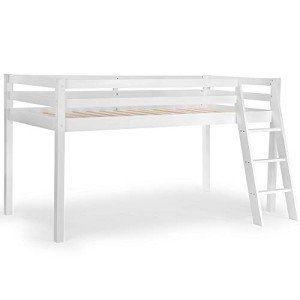The Ultimate Guide to Bunk Beds for Children: Safety, Styles, and Benefits
When it concerns styling a kid's space, moms and dads typically deal with the double obstacle of making the most of space while making sure convenience and functionality. Bunk beds have become a popular option that addresses these needs, offering not just sleeping arrangements but also contributing to a space's aesthetic. In this detailed guide, we will explore various elements of children's bunk beds, concentrating on their benefits, safety functions, designs, and considerations for parents contemplating this purchase.
Tabulation
- Advantages of Bunk Beds
- Security Features to Consider
- Kinds Of Bunk Beds
- Style and Style Options
- Maintenance Tips
- Frequently Asked Questions (FAQs)
1. Advantages of Bunk Beds
Bunk beds provide numerous advantages for kids and their moms and dads. Here are some essential advantages:
- Space-Efficiency: Bunk beds are an excellent service for smaller spaces. By stacking one bed on top of another, more floor space is readily available for play, storage, or research study areas.
- Cost-Effective: When children share rooms, bunk beds can lower the need for buying two different beds, hence saving money.
- Promotes Social Interaction: Bunk beds can help siblings or friends bond by sharing a space, producing opportunities for social development.
- Enjoyable Factor: The principle of sleeping "up high" adds a spirited element to bedtime, making the transition to sleeping alone much easier for some children.
- Versatile Design: Bunk beds come in various designs, colors, and develops to match any space style, permitting personalization that reflects the kid's personality.
2. Safety Features to Consider
Security is vital when it concerns kids's furnishings, particularly when it comes to bunk beds. Here are some vital safety features to examine:
| Safety Feature | Description |
|---|---|
| Sturdy Construction | Frames made of strong wood or metal are preferred. |
| Guardrails | Should be at least 5 inches high and extend along both sides of the upper bunk. |
| Ladder Design | Ensure ladders are securely connected and have non-slip steps. |
| Bed mattress Size & & Fit | Should fit snugly within the frame to avoid spaces. |
| Weight Limit | Always stick to the producer's weight limitation recommendations. |
3. Kinds Of Bunk Beds
Bunk beds can be found in numerous styles, catering to numerous needs, preferences, and room sizes. Here are some common types:
- Standard Bunk Bed: The many standard type, with one bed on top of another.
- Loft Bed: Features a high upper bed with space beneath for a desk or play location.
- Futon Bunk Bed: Combines a top bunk with a futon on the bottom, supplying versatility for seating and sleeping.
- L-Shaped Bunk Bed: This style has the top bunk set at a perpendicular angle to the bottom, developing a small corner location.
- Triple Bunk Bed: Accommodates three children utilizing stacked beds, perfect for big families or sleepovers.
4. Style and Style Options
When it comes to picking a style for children's bunk beds, the options are practically limitless. Here are some popular styles:
- Traditional Style: Often made of wood, these bunk beds feature elaborate information and are ideal for timeless or rustic-themed spaces.
- Modern Style: Characterized by clean lines and minimalist designs, modern bunk beds can be made of metal or wood.
- Themed Bunk Beds: Some brand names provide bunk beds shaped like castles, cars, or playhouses, making bedtime less of a chore.
- Convertible Bunk Beds: These can be separated into two individual beds, using versatility as children grow.
- Colorful Options: Bunk beds in dynamic colors can include a sense of joy and playfulness to any room.
5. Upkeep Tips
Preserving a bunk bed is essential for durability and safety. Here are some suggestions:
- Regular Inspections: Check for loose screws or bolts every couple of months and tighten them as needed.
- Cleaning: Wipe down frames routinely to avoid dust accumulation; consider using a vacuum for hard-to-reach locations.
- Bed mattress Care: Rotate bed mattress regularly and utilize protective covers to extend their life.
- View for Wear and Tear: Look for any indications of damage in the wood or metal and consider replacing parts if necessary.
- Teach Kids Safety Rules: Encourage kids to use ladders effectively and guarantee they understand the security features of their bed.
6. Often Asked Questions (FAQs)
Q1: What age is appropriate for sleeping in a leading bunk?
A1: Typically, kids aged 6 and older are advised for upper bunk sleeping, as they have the needed motor skills to climb securely.
Q2: Do bunk beds come with a bed mattress?
A2: Most bunk beds are offered as frames just, so you will require to buy bed mattress separately. Make sure that the bed mattress fits the frame snugly.
Q3: Can bunk beds be separated later on?
A3: Many styles permit conversion into 2 private beds, providing versatility for future requirements.
Q4: How can I ensure my kid's safety on a bunk bed?
A4: Comply with safety requirements and guarantee guardrails, a durable frame, and a protected ladder are in location.
Q5: Are there weight limits on bunk beds?
A5: Yes, constantly examine the maker's specifications regarding weight limits to make sure security.
Bunk beds for children can serve multiple functions while making sure security and style. With varied designs and designs available on the market, parents can discover an unit that not only maximizes bedroom space however also shows their kid's unique tastes. Similar to any furniture, comprehending security features, maintenance, and how they suit a kid's lifestyle will ensure that these beds remain a practical furniture service for many years to come.
Through mindful consideration and adherence to security guidelines, bunk beds can offer a long-lasting, enjoyable, and functional sleeping service that children love.

